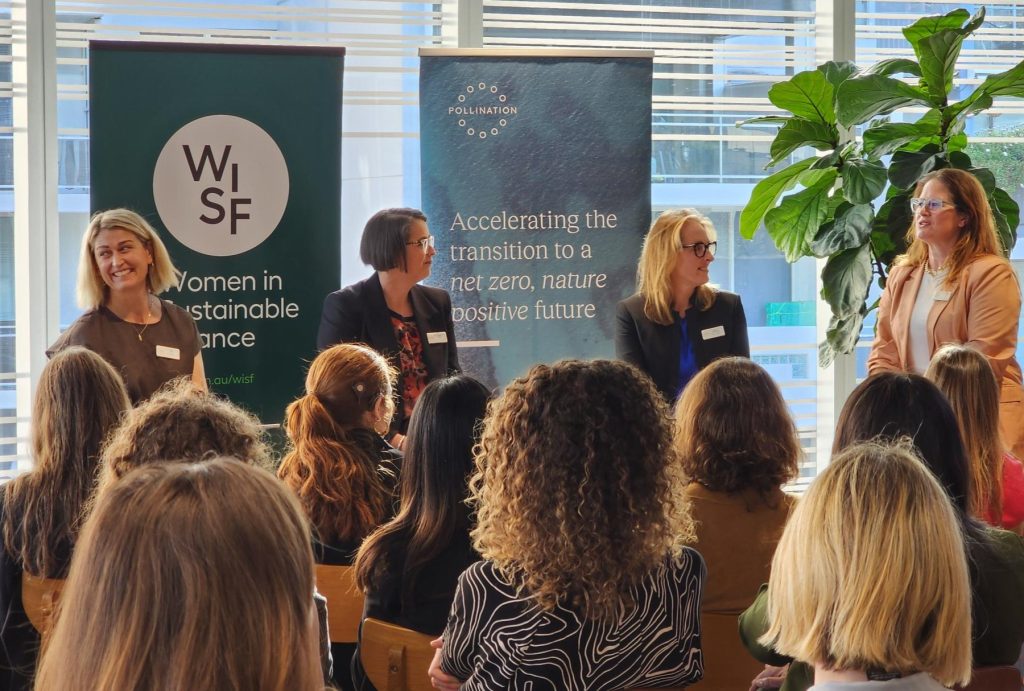This blog post follows a panel discussion at the Women in Sustainable Finance event hosted in Pollination’s Sydney headquarters in late August and moderated by Managing Director Beth Keddie.
There are moments in any transformation where progress seems inevitable and other times when obstacles emerge, energy and commitment are questioned and the path forward seems uncertain.
When we look at the net zero transition – a hugely important, massively ambitious undertaking that promises to remake our economies and our companies – we might well have entered such a challenging moment.
If the early part of this decade was about giving voice to lofty ambitions, setting targets and promising progress to consumers, shareholders and the world in general, we are now entering the ‘messy middle’ of the decade in which practical change must be implemented and executed.
All of a sudden, 2030 targets and deadlines that seemed distant are rushing towards us with great velocity. It turns out the execution part of net zero transition is pretty difficult but, for forward looking corporate leaders, this cannot become an excuse to slow down.
There are two reasons why that’s the case:
1) The alternative is many times harder and
2) There is significant value on the table for those that succeed.
That was the message being shared at the recent Women in Sustainable Finance event Pollination hosted in our Sydney headquarters. Leaders from across corporate Australia shared stories about how the hardest part of transition work remains. For many companies this hard slog must navigate complex challenges such as the pace of technology commercialisation, tight supply chains, competing capital allocation and more. Some sectors are particularly susceptible to transition fatigue. Think of industrials and energy, for example.

For Pollination this moment – challenging as it is – holds real opportunity. We still see some companies thriving their way towards net zero and the path they are taking is all the more conspicuous because it is less crowded. Those who have made the most progress and set themselves up to reap the benefits of the future economy, are the ones who have made their ambition a strategic priority and connected it deeply to their core business.
So how are different leaders approaching this and what insights did they share?
The context keeps changing
If delivering on existing climate action goals was not difficult enough, the broader sustainability agenda is speeding up and becoming more complex.
Sustainability disclosures are becoming mandatory for many corporate entities in Australia. A bill to establish an ISSB aligned mandatory reporting regime was recently passed through the Senate and will become law for a first tranche of large corporates at the beginning of 2025.
Alongside this shift, nature has joined climate as a key risk and opportunity for companies, bringing with it a new suite of obligations for corporates, not least of which to understand and act on the inherent financial risk accelerated nature loss is creating for business models. With growing pressure from shareholders, consumer and regulators and an urgent need to act to avoid very real near-term tipping points in key ecosystems, nature can’t be deferred until corporates have time to make time for it.
As the Head of Climate and Sustainability at one of the nation’s largest companies observed, mastering transition has become extremely challenging because ‘what good looks like’ is changing every 2-3 months, not every 1-2 years.
Prioritisation is key
Corporate leaders at the event observed that the pace and breadth of change is overwhelmingly a good thing but is making it incredibly challenging to develop the knowledge and expertise required to drive transition whilst carrying out the structural work of embedding change in the business.
Former Channel Infrastructure CEO Naomi James flagged the importance of clear-eyed prioritisation in making sure companies stay on track towards the overall outcomes they are seeking. There may be multiple and at times competing priorities but that does not mean all will be equally weighted.
“What you say no to is just as – if not more – important than what you are doing,” Naomi said.
“This means having a strategic understanding of where your focus lies and why, and then being able to effectively communicate that to customers and investors in a way that ties it back to your overall sustainability narrative.”
“Making sure you have a radical sense of clarity and that associated goals and activities are explicitly integrated at front line level means you need to secure internal buy in from across the company. “
Naomi shared a powerful case study from Channel Infrastructure, which had set an ambitious transition goal of ensuring 90% of impacted workforce be reallocated to new jobs within 6 months.
Setting such a clear and concrete objective and a robust plan helped to enlist staff in delivering on it and created a shared intent across the company. It also provided the laser focus to make sure the entire workforce was being technically readied for the skills that would be required in a transitioning business.
Extensive and clear internal and external consultation was identified as a key feature of delivering change. This involved a mindset of approaching key points of resistance encountered during consultation as a feedback gift – providing valuable insights into the issues that need to be solved for the strategic change to be successful.

The new sustainability dialogue
With changes underway around the reporting and disclosure companies undertake around climate and nature it can be tempting to see such reporting as a mere compliance burden to be managed. But Rebecca Mikula-Wright from the Investor Group on Climate Change said investors were increasingly seeking a dialogue with companies when it came to sustainability issues.
Rebecca told the corporate leaders gathered that investors are increasingly keen to move beyond top level statements to understand granular detail about the implementation of climate goals and targets.
“Having equipped themselves with the knowledge and experience to understand climate imperatives investors have been quick to identify the emerging nature agenda and are looking to understand how a new set of interdependencies will impact sustainability strategy and execution,” she said.
This approach was underlined by Nina James, former Head of ESG (Asia Pacific) at Blackstone Real Estate, who underlined the importance of translation: making sure different stakeholders understand the transition challenge in ways that are likely to resonate for them. This could include understanding how sustainability links to value creation or to how it creates risk exposures and potential losses. In the case of Blackstone such translation helped articulate a robust ESG strategy that helped the company raise capital and deploy it faster.
Being able to pursue transition goals while navigating a complex stakeholder environment requires a significant internal capability, Nina said. This can be likened to building a ‘support crew’ for change, so that multiple people within the company are champions for transition and each knows how to articulate the shift that’s needed in ways that resonate for different stakeholder groups and contexts.
Whole of company transition approach
The common thread through these discussions was the importance of moving transition responsibility beyond the chief sustainability officer and embedding it across all parts of the company – optimally framed and translated so that internal buy in for change is secured and external stakeholders can take confidence from the clarity of strategic purpose on display.
Much of the transition related work Pollination does with companies walks this line – helping to not only devise forward-looking transition strategy but to socialise and embed it within an organisation, creating the enabling conditions to better withstand the speedbumps and challenges that the current moment is throwing up and to make sure that momentum is maintained. Our corporate leaders are operating in the midst of the biggest economic transformation since the industrial revolution – the opportunity will be significant in such an historic moment for those who can stay the course and lean in.

